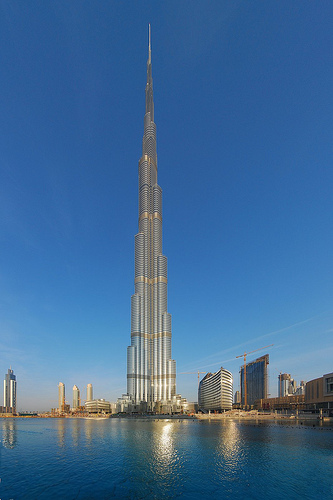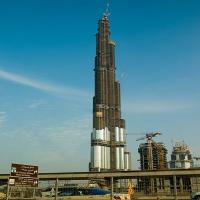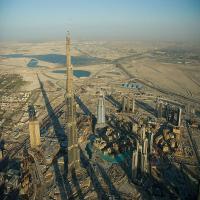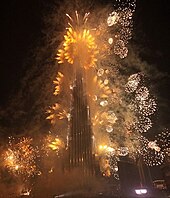Main menu
You are here
Khalifa Tower - Tallest man-made structure ever built - 828 m (2,717 ft)
Khalifa Tower



General information
| Location | Dubai, United Arab Emirates |
| Height (m) | 828 |
| Height (ft) | 2,717 |
| Number Of Floors |
160 habitable floors plus 46 maintenance levels in the spireand 2 parking levels in the basement |
| Area (m²) | 464,511 |
| Area (sq ft) | 5,000,000 |
| Cost | 1.5 billion USD |
| Architect | Adrian Smith at SOM |
| Status | Complete |
Burj Khalifa "Khalifa Tower"), known as Burj Dubai prior to its inauguration, is a skyscraper in Dubai, United Arab Emirates, and the tallest man-made structure ever built, at 828 m (2,717 ft). Construction began on 21 September 2004, with the exterior of the structure completed on 1 October 2009. The building officially opened on 4 January 2010, and is part of the new 2 km2 (490-acre) flagship development called Downtown Dubai at the 'First Interchange' along Sheikh Zayed Road, near Dubai's main business district.
The tower's architecture and engineering were performed by Skidmore, Owings, and Merrill of Chicago, with Adrian Smith as chief architect, and Bill Baker as chief structural engineer. The primary contractor was Samsung C&T of South Korea. In June 2010, Burj Khalifa was awarded the 2010 'Best Tall Building' for the Middle East & Africa by Chicago-based Council on Tall Buildings and Urban Habitat.
The total cost for the project was about US$1.5 billion; and for the entire 'Downtown Dubai', US$20 billion. In March 2009, Mohamed Ali Alabbar, Chairman of the project's developer, Emaar Properties, said office space pricing at Burj Khalifa reached US$4,000 per sq ft (over US$43,000 per m2) and the Armani Residences, also in Burj Khalifa, sold for US$3,500 per sq ft (over US$37,500 per m2).
The project's completion coincided with the global financial crisis of 2007–2010, and with vast overbuilding in the country, led to high vacancies and foreclosures. With Dubai mired in debt from its huge ambitions, the government was forced to seek multi-billion dollar bailouts from its oil-rich neighbor Abu Dhabi. Subsequently, in a surprise move at its opening ceremony, the tower was renamed Burj Khalifa, said to honor the UAE President, Khalifa bin Zayed Al Nahyan for his crucial support.
Current records
• Tallest skyscraper to top of spire: 828 m (2,717 ft) (previously Taipei 101 – 509.2 m/1,671 ft)
• Tallest structure ever built: 828 m (2,717 ft) (previously Warsaw radio mast – 646.38 m/2,121 ft)
• Tallest extant structure: 828 m (2,717 ft) (previously KVLY-TV mast – 628.8 m/2,063 ft)
• Tallest freestanding structure: 828 m (2,717 ft) (previously CN Tower – 553.3 m/1,815 ft)
• Building with most floors: 160 (previously Willis Tower – 108)
• World's highest elevator installation, situated inside a rod at the very top of the building
• World's fastest elevators at speed of 64 km/h (40 mph) or 18 m/s (59 ft/s) (previously Taipei 101 – 16.83 m/s)
• Highest vertical concrete pumping (for a building): 606 m (1,988 ft) (previously Taipei 101 – 449.2 m/1,474 ft)
• Highest vertical concrete pumping (for any construction): 606 m (1,988 ft) (previously Riva del Garda Hydroelectric Power Plant – 532 m/1,745 ft)
• The first world's tallest structure in history to include residential space
• Highest outdoor observation deck in the world (124th floor) at 442 m (1,450 ft)
• World's highest mosque (located on the 158th floor)
• World's highest installation of an aluminium and glass façade, at a height of 512 m (1,680 ft)
• World's highest swimming pool (76th floor)
Construction
 The tower was constructed by South Korean company, Samsung Engineering & Construction, which also did work on the Petronas Twin Towers and Taipei 101. Samsung Engineering & Construction built the tower in a joint venture with Besix from Belgium and Arabtec from UAE. Turner is the Project Manager on the main construction contract.
The tower was constructed by South Korean company, Samsung Engineering & Construction, which also did work on the Petronas Twin Towers and Taipei 101. Samsung Engineering & Construction built the tower in a joint venture with Besix from Belgium and Arabtec from UAE. Turner is the Project Manager on the main construction contract.
Under UAE law, the Contractor and the Engineer of Record, Hyder Consulting, is jointly and severally liable for the performance of Burj Khalifa.
The primary structural system of Burj Khalifa is reinforced concrete. Over 45,000 m3 (58,900 cu yd) of concrete, weighing more than 110,000 tonnes (120,000 ST; 110,000 LT) were used to construct the concrete and steel foundation, which features 192 piles, with each pile is 1.5 metre diameter x 43 metre long buried more than 50 m (164 ft) deep.[23] Burj Khalifa's construction used 330,000 m3 (431,600 cu yd) of concrete and 55,000 tonnes of steel rebar, and construction took 22 million man-hours. A high density, low permeability concrete was used in the foundations of Burj Khalifa. A cathodic protection system under the mat is used to minimize any detrimental effects from corrosive chemicals in local ground water.
The previous record for pumping concrete on any project was set during the extension of the Riva del Garda Hydroelectric Power Plant in Italy in 1994, when concrete was pumped to a height of 532 m (1,745 ft). Burj Khalifa exceeded this height on 19 August 2007, and as of May 2008 concrete was pumped to a delivery height of 606 m (1,988 ft), the 156th floor. The remaining structure above is built of lighter steel.
Burj Khalifa is highly compartmentalised. Pressurized, air-conditioned refuge floors are located approximately every 35 floors where people can shelter on their long walk down to safety in case of an emergency or fire.
Special mixes of concrete are made to withstand the extreme pressures of the massive building weight; as is typical with reinforced concrete construction, each batch of concrete used was tested to ensure it could withstand certain pressures.
The consistency of the concrete used in the project was essential. It was difficult to create a concrete that could withstand both the thousands of tonnes bearing down on it and Persian Gulf temperatures that can reach 50 °C (122 °F). To combat this problem, the concrete was not poured during the day. Instead, during the summer months ice was added to the mixture and it was poured at night when the air is cooler and the humidity is higher. A cooler concrete mixture cures evenly throughout and is therefore less likely to set too quickly and crack. Any significant cracks could have put the entire project in jeopardy.
The unique design and engineering challenges of building Burj Khalifa have been featured in a number of television documentaries, including the Big, Bigger, Biggest series on the National Geographic and Five channels, and the Mega Builders series on the Discovery Channel.
Opening
 The opening of Burj Khalifa was held on 4 January 2010.The ceremony featured a display of 10,000 fireworks, light beams projected on and around the tower, and further sound, light and water effects. Using the 868 powerful stroboscope lights that are integrated into the facade and spire of the tower, different lighting sequences were choreographed, together with more than 50 different combinations of the other effects.
The opening of Burj Khalifa was held on 4 January 2010.The ceremony featured a display of 10,000 fireworks, light beams projected on and around the tower, and further sound, light and water effects. Using the 868 powerful stroboscope lights that are integrated into the facade and spire of the tower, different lighting sequences were choreographed, together with more than 50 different combinations of the other effects.
The event began with a short film which depicted the story of Dubai and the evolution of Burj Khalifa. The displays of sound, light, water and fireworks followed. The portion of the show consisting of the various pyrotechnic, lighting, water and sound effects was divided into three. The first part was primarily a light and sound show, which took as its theme the link between desert flowers and the new tower, and was co-ordinated with the Dubai Fountain and pyrotechnics. The second portion, called 'Heart Beat', represented the construction of the tower in a dynamic light show with the help of 300 projectors which generated a shadow-like image of the tower. In the third act, sky tracers and space cannons enveloped the tower in a halo of white light, which expanded as the lighting rig on the spire activated.
The ceremony was relayed live on a giant screen on Burj Park Island, as well as several television screens placed across the Downtown Dubai development. Hundreds of media outlets from around the world reported live from the scene. In addition to the media presence, 6,000 guests were expected
Purpose
Burj Khalifa has been designed to be the centrepiece of a large-scale, mixed-use development that will include 30,000 homes, nine hotels such as The Address Downtown Dubai, 3 hectares (7.4 acres) of parkland, at least 19 residential towers, the Dubai Mall, and the 12-hectare (30-acre) man-made Burj Khalifa Lake.
The building has returned the location of Earth's tallest free-standing structure to the Middle East — where the Great Pyramid of Giza claimed this achievement for almost four millennia before being surpassed in 1311 by Lincoln Cathedral in England.
The decision to build Burj Khalifa is reportedly based on the government's decision to diversify from an oil-based economy to one that is service- and tourism-oriented. According to officials, it is necessary for projects like Burj Khalifa to be built in the city to garner more international recognition, and hence investment. "He (Sheikh Mohammed bin Rashid Al Maktoum) wanted to put Dubai on the map with something really sensational," said Jacqui Josephson, a tourism and VIP delegations executive at Nakheel Properties

